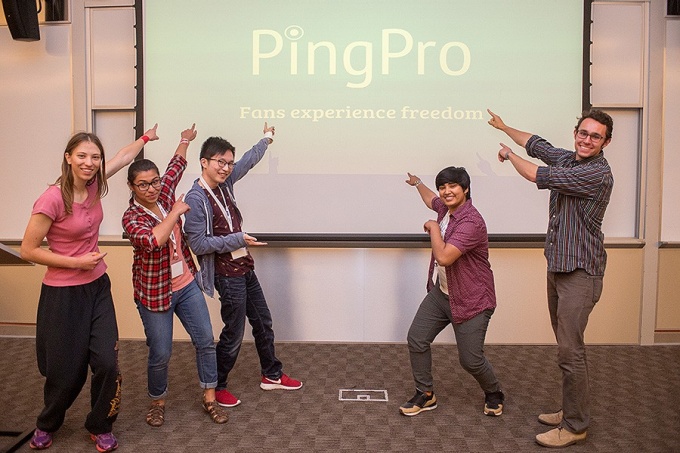Students Envision Future Stadiums During Hackathon

I love a good hackathon, and the one recently held at the University of Buffalo (UB) produced some worthy ideas.
More than 50 students spent 24 hours visualizing about the stadium of the future, concentrating on hospitality and guest experiences. Delaware North, the UB School of Engineering and Applied Sciences, the UB School of Management, and UB Athletics sponsored the event.
“Think about the last time you were at a stadium,” Rick Abramson, COO and executive vice president for Delaware North, told the students, as reported by the UB Reporter. “What did you like? What turned you off or what was lacking? Were the seats too small? Was the food good? Could you find a jersey to buy? Talk to friends over Wi-Fi? What would you do better? We want to learn from you. How can we satisfy people of your age and demographic?”
A strength of this hackathon was the different groups of students—engineering, management, etc.—working together toward a common goal.
“There’s a lot of literature—much of it has come out of the U.S. Army, for example — that shows that groups that have diversity of views and expertise will create better outcomes and solutions and products than groups that are more homogeneous,” Liesl Folks, dean of the School Engineering and Applied Sciences, told the UB Reporter.
Eight teams ended up pitching their ideas to a panel of judges, and first-, second-, and third-place winners were selected.
The team that won first place developed a wearable wristband that replaces a fan’s tickets and ID and lets someone make quick, cashless purchases at concession stands.
Please read the full UB Reporter article to learn more about the hackathon and to find out which ideas were awarded second and third places.
(Image: UB Reporter)
Bathroom Laws, Overtime Rules—Fireside Chats at VenueConnect

Educational opportunities are prevalent at this year’s VenueConnect in Minneapolis, Minnesota, July 23-26. And they don’t just happen in meeting rooms. Join our Fireside Chats on the trade show floor and participate in important and exciting industry discussions that will impact your staff and your guests. Let’s take a look at a few of them.
Providing Bathrooms for All Guests
Saturday, July 23, 5-5:30 p.m., and Sunday, July 24, 10:40-11:25 a.m.
Bathrooms and gender have made the news a lot this past year, with groups and acts cancelling events in some states and cities in protest of laws. Join a discussion lead by Landers Center Executive Director Todd Mastry on this emerging topic and how venues are meeting their guests’ needs.
The Fan Experience: Changing the Game with Food and Beverage Technology
Sunday, July 24, 1:10 – 1:30 p.m.
Oracle Hospitality Sports and Entertainment will dive into the findings of their recently conducted research report on the fan experience at sporting events around the world. More specifically, the research focuses on the role that food and beverage at a stadium plays in the overall fan experience. Come engage in hearing more about the results of the study and what Oracle Hospitality Sports and Entertainment can do for your stadium, arena, or venue.
Overtime Law Changes and What You Need to Know
Sunday, July 24, 1:35-2:20 p.m.
Cartsen Peterson, an attorney with Hawley Troxell, specializes in employment law and will guide attendees on everything to know about the recent U.S. Department of Labor update to the overtime rules—rules that will affect thousands of employees and venues.
Other Fireside Chats include talks about mobile payments, energy optimization for venues, risk and threat identification, acoustic trends, mobile apps, and self-promoted events.
Register now for VenueConnect so you don’t miss out on learning more about these topics first hand.
Why Taking Photos at Events is Good for You

Musician Alicia Keys recently made headlines by having a phone-free concert. Fans locked their devices into a pouch made by Yondr. Attendees keep the pouches with them, but they could only be unlocked by venue employees.
Yondr was founded by Graham Dugoni two years ago, and already artists and acts such as Louis C.K., the Lumineers, and Dave Chappelle have hired the company to police fans’ phone use.
“If you haven’t been to a phone-free show, you just don’t know what you’re missing,” Dugoni told The Washington Post. “There’s something about living in real life that can’t be replicated.”
I hate to break it to you, sir, but smartphones are a part of real life, too. I’ve been to concerts where multiple phones were in the air and I’ve been to shows where no phones were there. THEY WERE BOTH THE SAME EXPERIENCE. Sorry to yell at you. This is something I feel very passionate about. I admit, though, my passion for the freedom to take a photo is probably equal to someone’s passion for having a phone-free event.
Consider this, however. Taking photos actually helps you enjoy events more.
In a recent study published in the Journal of Personality and Social Psychology, researchers found that those who took photos enjoyed and were more engaged with their experiences.
“To the best of our knowledge, this research is the first extensive investigation examining how taking photos affects people’s enjoyment of their experiences,” wrote Kristin Diehl, PhD, of the University of Southern California; Gal Zauberman, PhD, of Yale University; and Alixandra Barasch, PhD, of the University of Pennsylvania. “We show that, relative to not taking photos, photography can heighten enjoyment of positive experiences by increasing engagement.”
The researchers included more than 2,000 participants in the study, having them take part in an activity where they either took photos or didn’t. The participants then completed a survey and in almost every instance those who took photographs reported higher levels of enjoyment than those who didn’t.
“Surprisingly, despite the prevalence of photo-taking today, prior research has not studied how taking photos affects the experiences being photographed,” the researchers wrote. “In this paper, we are interested in this very question: how does photo-taking affect people’s enjoyment of their experiences? Lay beliefs regarding this question vary widely. For example, some business owners and performers have banned cameras from restaurants and concerts, arguing that taking photos will ruin individuals’ experiences. However, the prevalence of photo-taking across countless situations suggests that many individuals do not share this opinion.”
Thank you, science.
(photo credit: ShutterRunner via photopin cc)
Allied Corner: The Psychology of Color

“Color is the place where our brain and the universe meet.”—Paul Klee
Our understanding of color has come a long way since Henry Ford told Model T customers they could “have any color they wanted as long as it was black.”
Today, we know colors have a physiological impact on the brain. Scientists tell us that when we view a color, our eyes send a message to the hypothalamus, which then sends messages to the pituitary gland and thyroid glands, causing the body to release hormones that affect mood, emotions, and behavior.
Color is an important part of our everyday lives. We slow down for yellow lights, stop for red lights, and go when the lights turn green. Color has even found its way into our language. When we’re sad, we say we “feel blue.” When we’re angry, we “see red.” And when we’re jealous, we’re “green with envy.”
Color also plays a critical role in triggering and reinforcing brand recognition. When we see a certain shade of green, we think of Holiday Inn. When we see a certain orange, we think of Home Depot. Some company colors, such as UPS brown and Target red are even trademarked.
We understand that effective use of color is one of the keys to success in creating seating for the hospitality industry. It has to complement a company’s design aesthetic, blend seamlessly with the existing décor, and enhance, or at the very least, not detract from the overall enjoyment of visitors and guests.
According to Josh Swy, MTS Seating’s director of design, we interact with color differently when it’s part of a seating experience. “Seating is something we touch and feel and connect with, and
“Seating is something we touch and feel and connect with, and color is a critical part of that exchange,” Swy said. “When you engage color on that tactile level, it can really speak to you.”
MTS customers have the final say when it comes to color selection.
“They tell us what they want,” Swy said. “We help them achieve it, which not only means matching the desired color as closely as possible but finding the right designer and fabric supplier to keep it from being cost-prohibitive. If our customers are happy, we’re happy, and we do everything we can to make sure they’re happy.”
(Image: EnKayTee/Creative Commons)
Congratulations to Our Latest CVPs
Congratulations to the following individual who was recently awarded the Certified Venue Professional (CVP) designation.
Thanks to the generous funding and support from the IAVM Foundation, the CVP program was launched in August 2015 at VenueConnect in Baltimore. It recognizes the competence of middle-to-senior-level managers of public assembly venues as well as assisting the managers in creating a professional roadmap in the venue industry.
The CVP designation says three important things about an individual: he or she is a capable professional, is committed to the industry, and is pledged to continued professional growth and development. Venue professionals who earn the CVP designation are recognized, by those inside and outside the industry, as skilled in their profession.
 Wendy Atkinson, CVP
Wendy Atkinson, CVP
Rentals & Programming Manager
Chan Centre for the Performing Arts
Vancouver, British Columbia
 Sarah Brown, CVP
Sarah Brown, CVP
Nashville, Tennessee
 Kathryn Carlson, CVP
Kathryn Carlson, CVP
Guest Services & Security Manager
American Airlines Center
Dallas, Texas
 David Humphrey, CVP
David Humphrey, CVP
Production Manager
Chan Centre for the Performing Arts
Vancouver, British Columbia
 Christopher G. Post, CVP
Christopher G. Post, CVP
Operations Manager
Amarillo Civic Center Complex
Amarillo, Texas
 Mike Santa, CVP
Mike Santa, CVP
General Manager
Indiana University Event Services
Bloomington, Indiana
Do you want to receive a Front Row News weekly digest?
Categories
- Allied (861)
- Architecture (147)
- Arenas (747)
- Career (897)
- Convention Centers (895)
- Education (623)
- Events (1,544)
- Food & Beverage (193)
- Foundation (113)
- Guest Experience (1,496)
- Industry News (2,270)
- Leadership (1,888)
- Marketing (150)
- Membership (2,000)
- Music (213)
- Performing Arts Centers (454)
- Professional Development (409)
- Research (127)
- Safety & Security (442)
- Sports (763)
- Stadiums (608)
- Student (159)
- Technology (516)
- Ticketing (92)
- Touring (82)
- Trends (364)
- Uncategorized (725)
- Universities (218)
- Video (25)
- Young Professional (198)
Twitter Feed
- Twitter feed loading
Recent Posts
- McNamara Named General Manager of Will Rogers Memorial Center
- Matt Rife Breaks Record for Most Tickets Sold for a Comedy Show at Honda Center
- The Events Industry Council Recognizes the Miami Beach Convention Center (MBCC) for Achieving Gold Level Sustainability Certification
- Raleigh Convention Center Shares Designs of Upcoming Expansion
- Acrisure Arena Wraps ‘Magnificent 7’ with Record-Setting Week of Live Entertainment, Welcoming Fans from All 50 States
Categories
- Allied
- Architecture
- Arenas
- Career
- Convention Centers
- Education
- Events
- Food & Beverage
- Foundation
- Guest Experience
- Industry News
- Leadership
- Marketing
- Membership
- Music
- Performing Arts Centers
- Professional Development
- Research
- Safety & Security
- Sports
- Stadiums
- Student
- Technology
- Ticketing
- Touring
- Trends
- Uncategorized
- Universities
- Video
- Young Professional
Archives
- November 2025
- October 2025
- September 2025
- August 2025
- July 2025
- June 2025
- May 2025
- April 2025
- March 2025
- February 2025
- January 2025
- December 2024
- November 2024
- October 2024
- September 2024
- August 2024
- July 2024
- June 2024
- May 2024
- April 2024
- March 2024
- February 2024
- January 2024
- December 2023
- November 2023
- October 2023
- September 2023
- August 2023
- July 2023
- June 2023
- May 2023
- April 2023
- March 2023
- February 2023
- January 2023
- December 2022
- November 2022
- October 2022
- September 2022
- August 2022
- July 2022
- June 2022
- May 2022
- April 2022
- March 2022
- February 2022
- January 2022
- December 2021
- November 2021
- October 2021
- September 2021
- August 2021
- July 2021
- June 2021
- May 2021
- April 2021
- March 2021
- February 2021
- January 2021
- December 2020
- November 2020
- October 2020
- September 2020
- August 2020
- July 2020
- June 2020
- May 2020
- April 2020
- March 2020
- February 2020
- January 2020
- December 2019
- November 2019
- October 2019
- September 2019
- August 2019
- July 2019
- June 2019
- May 2019
- April 2019
- March 2019
- February 2019
- January 2019
- December 2018
- November 2018
- October 2018
- September 2018
- August 2018
- July 2018
- June 2018
- May 2018
- April 2018
- March 2018
- February 2018
- January 2018
- December 2017
- November 2017
- October 2017
- September 2017
- August 2017
- July 2017
- June 2017
- May 2017
- April 2017
- March 2017
- February 2017
- January 2017
- December 2016
- November 2016
- October 2016
- September 2016
- August 2016
- July 2016
- June 2016
- May 2016
- April 2016
- March 2016
- February 2016
- January 2016
- December 2015
- November 2015
- October 2015
- September 2015
- August 2015
- July 2015
- June 2015
- May 2015
- April 2015
- March 2015
- February 2015
- January 2015
- December 2014
- November 2014
- October 2014
- September 2014
- August 2014
- July 2014
- June 2014
- May 2014
- April 2014
- March 2014
- February 2014
- January 2014
- December 2013
- November 2013
- October 2013
- September 2013
- August 2013
- July 2013
- June 2013
- May 2013
- April 2013
- March 2013
- February 2013
- January 2013
- May 2012
- March 2012
- December 2011
- November 2011
- October 2011
Recent Comments
- Frank Bradshaw, Ph.D., CVE on John Meyer, CVE, a Tireless Advocate of Certification for Venue Professionals, Has Died
- Neil Sulkes on Hilary Hartung, Friend to Many in Venue Marketing, Has Left Us
- Jason Parker, CVE on The Devastation of Hurricane Helene and How We Can Support One Another
- Larry Perkins on Touhey Testifies Against Speculative Ticketing Before Congressional Subcommittee
- Peter Secord on Major Players for Planned Elkhart Amphitheater Were in the Mix at VenueConnect
